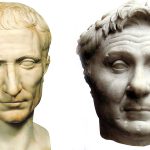Famous Carthaginian Great Harbour was an artificial protected water reservoir. In ancient times this type of port was called the Greek cothon (“drinking vessel”). These types of constructions were built especially in lands controlled by Phoenicians, e.g. Sicily or Cyprus.
The Grand Harbour in Carthage had a rectangular commercial harbour connected to an internally guarded military harbour. The protected section of the harbour was circular and was surrounded by an outer ring of structures in which ships requiring maintenance docked. In the middle of the water, there was an island on which ships also landed. The harbour was equipped with slipways, after which ships were released into the water.
Naturally, the harbour had workshops and warehouses in which oars, rigging, wood or canvas were stored. What’s more, on the island in the middle of the basin there was a special, higher structure from which the main admiral could observe the entire Harbour and the sea.
Appian from Alexandria estimated that the military part of the Harbour could accommodate up to 220 military ships. Both Harbours were surrounded by an external wall, and the main entrance to the harbour could be blocked by iron chains in the event of an emergency.
The harbour of Carthage described by Appian is as follows:
The harbors had communication with each other, and a common entrance from the sea seventy feet wide, which could be closed with iron chains. The first port was for merchant vessels, and here were collected all kinds of ships* tackle. Within the second port was an island which, together with the port itself, was enclosed by high embank- ments. These embankments were full of shipyards which had capacity for 220 vessels. Above them were magazines for their tackle and furniture. Two Ionic columns stood in front of each dock, giving the appearance of a continu- ous portico to both the harbor and the island. On the island was built the admiral’s house, from which the trum- peter gave signals, the herald delivered orders, and the admiral himself overlooked everything. The island lay near the entrance to the harbor and rose to a considerable height, so that the admiral could observe what was going on at sea, while those who were approaching by water could not get any clear view of what took place within. Not even the incoming merchants could see the docks, for a double wall enclosed them, and there were gates by which merchant ships could pass from the first port to the city without traversing the dockyards. Such was the appear- ance of Carthage at that time.
– Appian of Alexandria, Roman history, VIII 96









